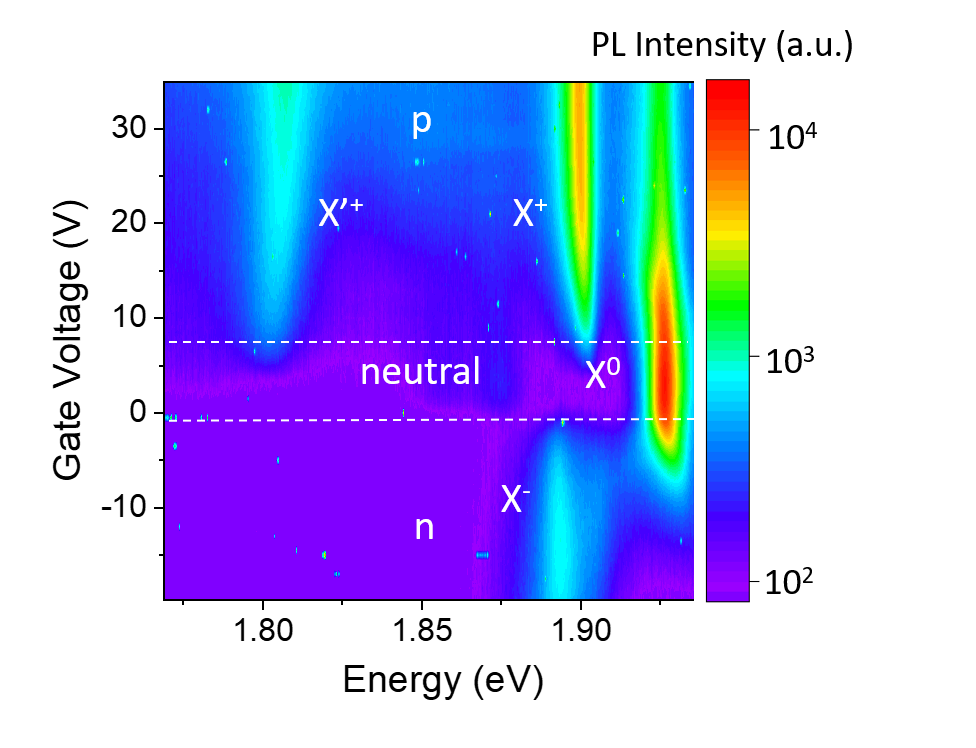A recently published work from the “Electrons Photons Surfaces” group explores the valley degree of freedom of charged excitons in atomically thin semiconductors.
Transition metal dichalcogenide (TMD) monolayers host degrees of freedom with promising properties for future opto-electronic devices. Indeed, electrons and holes in MoS2 monolayers exhibit a unique coupling between the spin and the crystal momentum, also referred to as the valley. A crucial requirement for future applications is therefore the possibility to initialize the spin/valley degree of freedom in these materials. In a work performed at PMC, a very efficient optical initialization of the valley degree of freedom in charge-tunable MoS2 monolayers encapsulated with hexagonal boron nitride (h-BN) at cryogenic temperatures was achieved.
The sample was fabricated by Sangjun Park and consists of a stack of thin layers of MoS2, graphite, and h-BN. The substrate contains pre-patterned electrical contacts which were evaporated by Steve Arscott (from IEMN, Lille). This device permits to inject both electrons and holes into the MoS2 layer by choosing an appropriate gate voltage. A schematic of the fabricated sample is shown in Fig.1(a), and microscope images of the sample are shown in Fig.1(b) and Fig.1(c).
Figure 1 (a) Schematic side-view of the sample. The MoS2 monolayer is encapsulated between two thin h-BN flakes to provide high optical quality and to prevent photodoping effects. Thin graphite flakes were used to provide an electrical control, via the gate bias voltage Vg, of the resident carrier concentration in the monolayer. (b) Optical microscope image of the sample under white light illumination. c Dark-field image of the sample, revealing clean interfaces with no visible bubbles after the formation of the heterostructure. The scale is the same as in panel (b).
Using this sample, the team reports in photoluminescence a large steady state valley polarization of the different excitonic complexes following circularly-polarized laser excitation. An efficient valley initialisation of positively-charged excitons is demonstrated, which have so far proved to be elusive in non-encapsulated monolayers due to defect and laser-induced large electron doping. It was also found that negatively-charged excitons present a polarization of 70% which is unusually large for non-resonant excitation. This large valley polarization is attributed to the particular band structure of MoS2. In addition, the group demonstrates that circular excitation induces a dynamical polarization of resident electrons and holes––as recently shown in tungsten-based monolayers.
This work broadens our understanding on the different mechanics that may influence the robustness of the valley polarization of quasiparticles in TMD monolayers and the dynamical valley polarization of resident carriers, and constitutes an important step towards the development of valleytronic devices based on TMD monolayers. Indeed, both highly-polarized excitons and valley polarized resident carriers influence the transport and the optical properties of TMDs and may be detected and manipulated in experiments such as the valley Hall effect.
Publication
Efficient valley polarization of charged excitons and resident carriers in Molybdenum disulfide monolayers by optical pumping,
Sangjun Park, Steve Arscott, Takashi Taniguchi, Kenji Watanabe, Fausto Sirotti and Fabian Cadiz, Communications Physics 5, 73 (2022)




